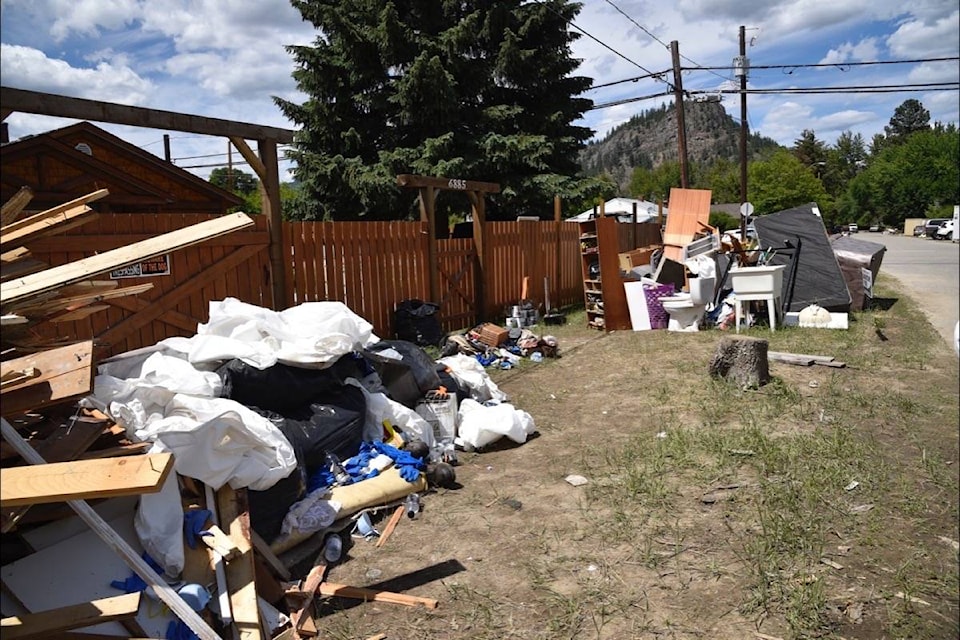All that flood-damaged garbage has to go somewhere – and it turns out, it’s expected to shorten the lifespan of the Grand Forks landfill by about four years.
After the Regional District of Kootenay Boundary and the province reached an agreement to have the province pay tipping fees for flood-affected homes, garbage and debris has been coming into the landfill at record rates.
It’s too soon to have a figure on overall traffic, said Tim Dueck, solid waste management coordinator for the RDKB, but he said there have definitely been some all-time record days for vehicle traffic, especially on weekends.
All of that garbage coming in could shorten the lifespan of the landfill by about four years, Dueck said. Though that’s a preliminary estimate, it is not insignificant, especially as landfill remediation can be costly.
The RDKB is currently estimating 417 homes impacted by flooding, he said, and they use formulas from other agencies, notably the American Federal Emergency Management Agency (FEMA) to determine how much flood-damaged debris to expect.
“That formula [shows] 100 tons of garbage for a house and a yard, now not all of that comes here, not all of that is loaded out and taken here, but potentially some of these homes will be demolished, and some are soaking wet,” he said.
The preliminary estimate the RDKB gave to the province is 21,684 additional tons of garbage as a result specifically of flooding.
While Dueck couldn’t reveal the financial side of the agreement for tipping fees with the province, he did say that the tipping fee at the landfill is $110 per ton – meaning that the province could be looking at over $2-million in landfill costs associated with flooding.
That is strictly an estimate, but one that gives residents an idea of the scale of the impact, Dueck said.
Now, Dueck said, not all of that garbage will rest at the Grand Forks landfill. Large parts of it are divertable, like clean wood (which is chipped and reused), and metal from appliances.
The only true trouble comes when the landfill waste isn’t correctly sorted, or when big, bulky items come to the landfill, he said. That means it can’t be compressed correctly, creating air pockets leading to methane build up. Those are challenges the landfill is managing for, but there is a risk of landfill fires, he said.
“Methane production is something we are always trying to mitigate,” he said.
“There’s no diversion for wet insulation, for instance,” Dueck said. He also pointed to mattresses, drywall and couches as being tough landfill items.
“These big bulky items, they are the worst for us to manage,” he said.
The current estimates indicate the landfill’s longevity might be shortened by as much as four years because of the additional volume, and that’s with the estimate that as much as half of the debris can be diverted, he said.
All of this underscores the importance of residents sorting their landfill waste as much as possible. Not only is it better for the environment, but it will help “maximize diversion and try to minimize the impact on the life of the landfill,” Dueck said.
“Hosed off, dried, it makes diversion possible,” Dueck said. “If they are covered in mud and debris that is not recyclable. [Most of the materials] are in good shape.” Much of the material coming from flooded homes is now damp and not soaking wet, he added, which is a good sign.
Tipping fees are currently being waived at the landfill and are being paid by the province, for the foreseeable future.
RDKB information officer Frances Maika said they are asking residents to have their materials to the landfill before the end of June, and have set that as the tentative date for the end of fee coverage by the province, but if there continues to be a need after that date, the RDKB will re-evaluate, she said.
The RDKB will be examining the impact of the flood on the landfill, and will take it into consideration when developing a landfill remediation plan, Dueck said.
